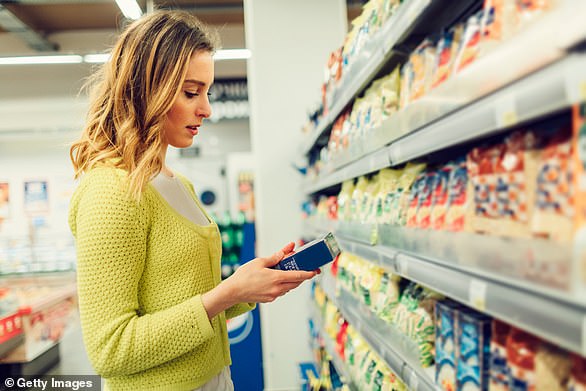THE NUTRITION PANEL
Portion size
When reading the Nutrition Information Panel (NIP), pay close attention to the serving size, the number of servings per package, and the breakdown of nutrients in the product.
The per 100g column is helpful here when comparing nutrients between products, as serving sizes are simply stated by the manufacturer and can vary from product to product.
Energy
The second thing to look at in the NIP is energy, which is measured in kilojoules (kJ) or calories.
the NDSS reports that the amount of energy each of us needs depends on many factors and will vary from person to person.
You should limit your consumption of discretionary or junk foods, that is, those that have more than 600 kJ per serving.

While carbs aren’t bad for you, you should keep an eye on them because the words “total carbs” include both sugars and starches in foods (stock image)
Fat
If you’re looking to make a healthy and nutritious food decision, it’s vital that you look at the amount of fat in a product.
‘”Total fat” includes all polyunsaturated, monounsaturated, saturated, and trans fats in the food. It is important to consider both the amount and type of fat,” reports the NDSS.
With the total amount of fat, eat for health recommends that you should aim for less than 10g per 100g.
With milk and yoghurt, look for less than 2g per 100g, and with cheese, go for those with less than 15g per 100g.
Saturated fat is the worst kind of all and should be limited to less than 3g per 100g.
carbohydrates
While carbs aren’t bad for you, you should watch them because the words “total carbs” include both sugars and starches in foods.
The amount of ‘sugars’ tells you how much of the total carbohydrate is made up of sugars.
It includes both added sugars and natural sugars like lactose in milk and fructose in fruit.
Keep them low to stay healthy, and for a quick way to identify what part of your food is sugar, check the ingredient list.
If sugar or one of the other words for sugar, such as stevia, fructose, glucose, syrup, or honey, is one of the first on the list, you know you’re in trouble.
Sodium
Sodium is one of the most important things to look at in the NIP.
Whenever possible, choose ‘reduced’ or ‘no salt added’ salt products.
Alternatively, choose products with less than 120mg per 100g.
THE LIST OF INGREDIENTS
If you want to quickly see what’s in a product, check the ingredient list, which should see all ingredients listed in descending order by weight.
If sugar or fat or one of their ‘other names’ is at the top of the list, packaged food probably isn’t so good for you.
As a general rule, opt for products with whole, natural ingredients and try to choose packaged foods with small lists.
THE CLAIMS
Food manufacturers often use nutrition claims on their packaging to attract the attention of the buyer.
While the claim may be true, it can also be misleading, so it helps to know what nutrition claims mean.
reduced salt
The ‘reduced salt’ tag might get you to grab the item and put it in your shopping cart, but you shouldn’t be that quick without checking the tag.
Reduced salt simply means that the product contains at least 25 percent less salt than the regular product.
However, the reduced salt version can still be high in salt.
light or light
You may see these words and assume they refer to reduced fat content.
But this can also be used to describe the taste, texture, or color of a food.
For example, light olive oil is lighter in color and flavor, but not low in fat.


You may see the words light or lite and assume they refer to reduced fat content, but they can also be used to describe the taste, texture, or color of a food (stock image)
no added sugar
This means that the product does not contain added sugars, such as sucrose, honey or glucose.
But the item may still contain natural sugars, such as milk (lactose), fruit (fructose), or other carbohydrates, which can affect your blood glucose levels.
reduced fat
Like a reduced salt label, a reduced fat label means the product contains at least 25 percent less fat than the regular product.
However, this does not mean that it is low in fat.
HEALTH STAR RATING SYSTEM
The last thing you should check out is the health star rating system, which is designed to help you make healthier food choices at a glance.
Packaged foods are rated between 1/2 and 5 stars.
The rating is calculated based on ingredients that increase the risk of obesity and contribute to other chronic diseases. The more stars, the healthier the product.
.
